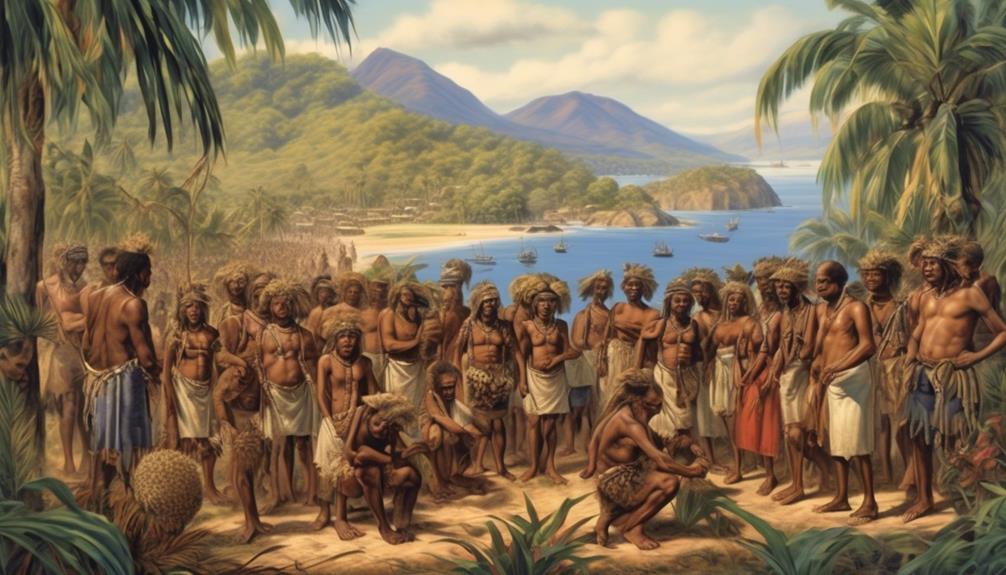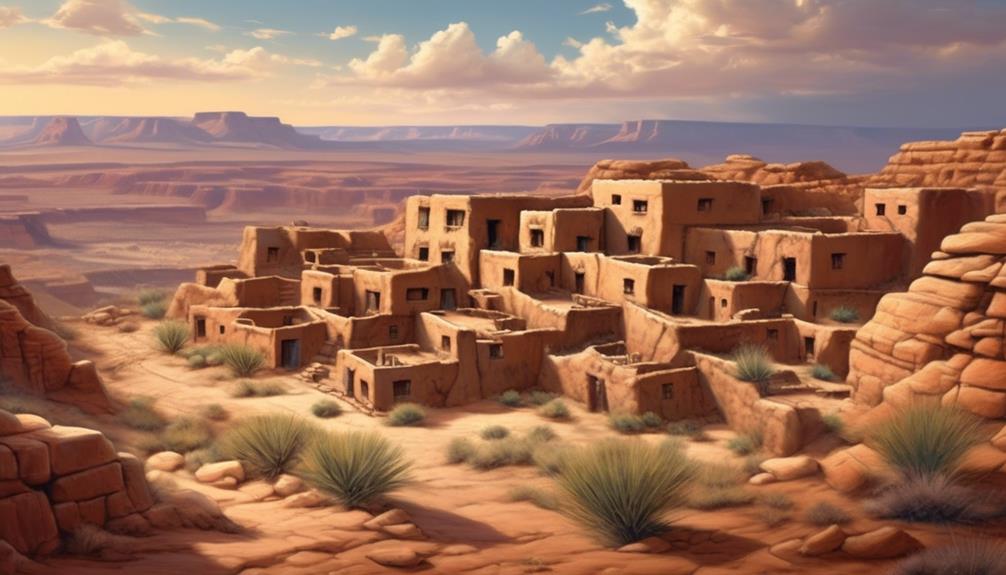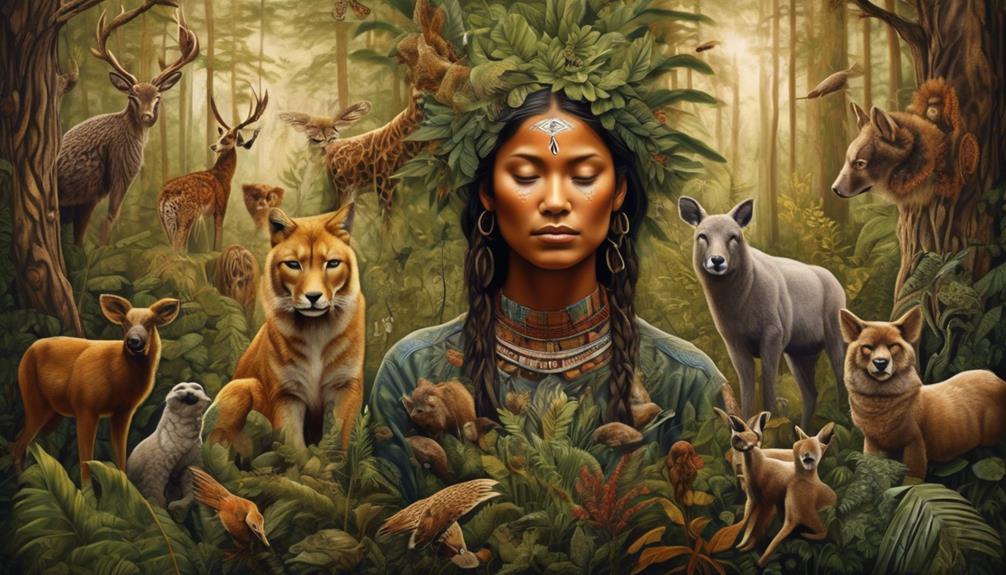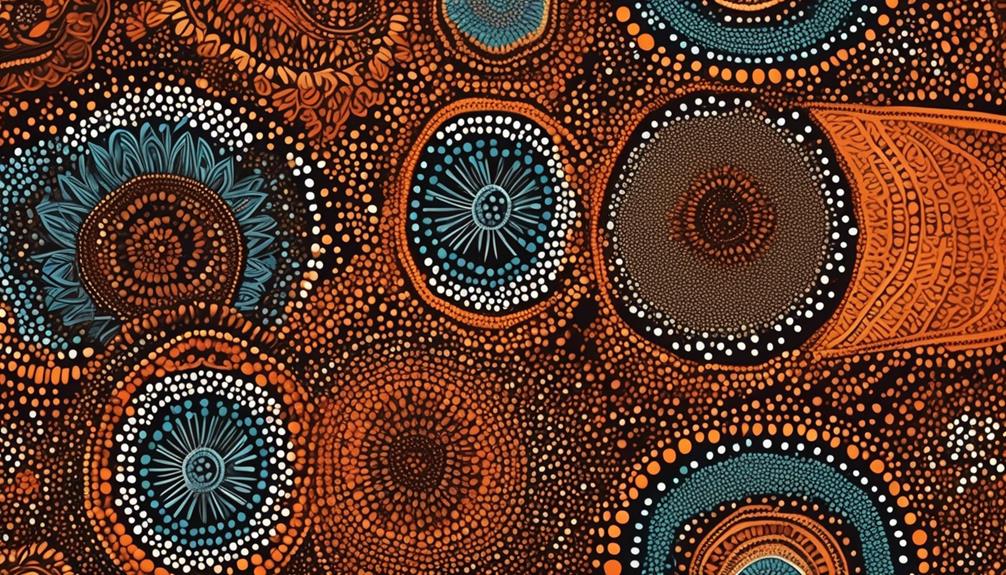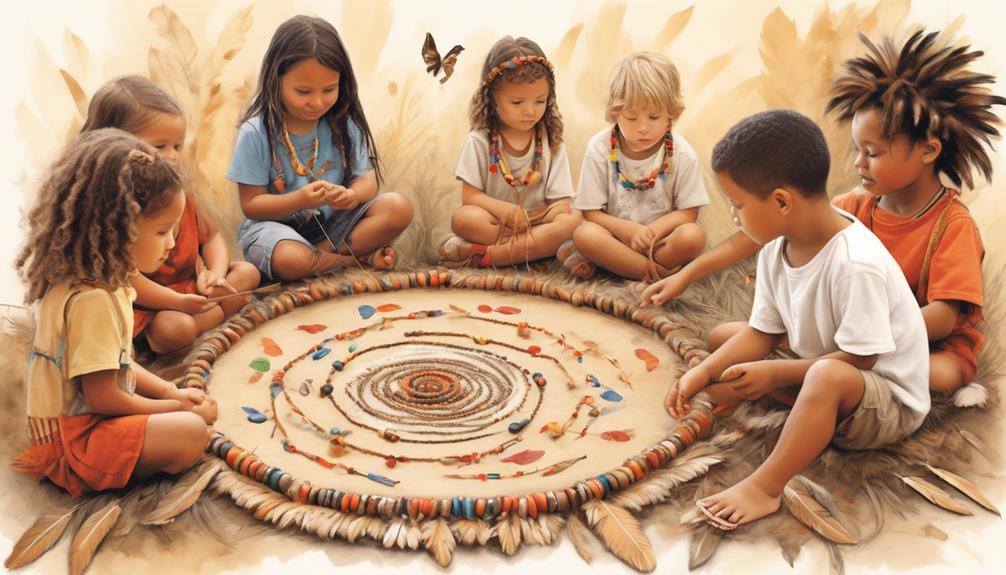As we delve into the complex tapestry of history, we often ponder the enigma of why Europeans were able to conquer and replace the Indigenous Australians, but faced challenges in displacing the inhabitants of New Guinea.
The juxtaposition of these two experiences raises thought-provoking questions about the intricate interplay of factors that contributed to such divergent outcomes. Our exploration will unravel the historical context, environmental factors, agricultural practices, resistance, and adaptation, and the profound impact of colonization in unraveling this enigma.
What unique circumstances and dynamics allowed for such disparate trajectories to unfold?
Key Takeaways
- British colonization in Australia led to displacement and marginalization of Aboriginal Australians, while European presence and trade relations in New Guinea were less aggressive.
- European diseases, land dispossession, and forced assimilation policies altered the social and cultural fabric of Aboriginal communities, whereas New Guinea's rugged terrain and diverse indigenous societies presented challenges to European colonization.
- Europeans utilized advanced agricultural practices and land management systems, facilitating population growth and specialization of labor, while Natives of New Guinea primarily used swidden agriculture, limiting agricultural production scale.
- Aboriginal communities displayed resistance through deep understanding of the land, guerrilla warfare tactics, and preservation of cultural knowledge, while European settlers adapted by leveraging advanced technology, exploiting natural resources, and implementing systematic colonization strategies.
Historical Context
In comparing the historical context of replacing Aboriginal Australians with Natives of New Guinea, it becomes evident that colonial policies and practices significantly impacted both groups, albeit in distinct ways.
European exploration led to the colonization of Australia and New Guinea, but the nature of colonialism and trade relations differed between the two regions. In Australia, British colonization resulted in the displacement and marginalization of the Aboriginal Australians as European settlers sought to exploit the land for agriculture and resources. The impact of European diseases, dispossession of land, and forced assimilation policies drastically altered the social and cultural fabric of Aboriginal communities.
On the other hand, New Guinea's rugged terrain and diverse indigenous societies presented challenges to European colonization, leading to a less aggressive approach compared to Australia. Despite European presence and trade relations, the Natives of New Guinea were able to maintain significant autonomy and cultural practices.
The complex trade networks and resistance strategies of the New Guinean communities played a role in shaping the colonial interactions, resulting in a different historical trajectory compared to that of the Aboriginal Australians.
Environmental Factors

The distinct historical trajectories of Aboriginal Australians and Natives of New Guinea in relation to colonial policies and practices set the stage for evaluating the environmental factors that influenced the experiences of these indigenous groups. When examining the ability of Europeans to replace Aboriginal Australians but not the Natives of New Guinea, it becomes evident that geographic barriers and climate differences played a crucial role in shaping the outcomes for these two groups.
| Environmental Factors | Aboriginal Australians | Natives of New Guinea |
|---|---|---|
| Geographic Barriers | The vast and arid landscapes of Australia presented challenges for European settlers to navigate and establish infrastructure. | The rugged terrain and dense rainforests of New Guinea acted as natural barriers, making it difficult for European settlement and exploitation of resources. |
| Climate Differences | The harsh and unpredictable climate of Australia, with its deserts and limited water sources, posed significant challenges for European colonization and agriculture. | New Guinea's tropical climate, with heavy rainfall and high humidity, was not conducive to European settlement and agricultural practices. |
The geographic barriers in Australia and the challenging climate differences in both regions significantly influenced the ability of Europeans to replace indigenous populations. These factors hindered European efforts to establish a sustained presence and exploit resources, ultimately impacting the outcomes for Aboriginal Australians and Natives of New Guinea.
Agricultural Practices
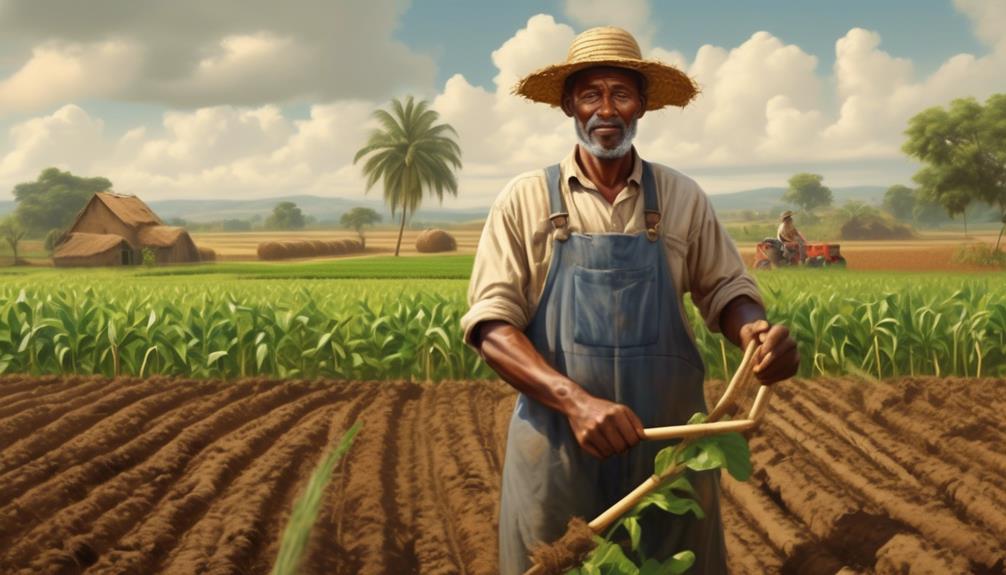
Despite facing similar challenges due to environmental factors, our agricultural practices diverged significantly from those of the Natives of New Guinea, leading to disparate outcomes for our respective indigenous communities.
Traditional farming methods in Europe involved the use of plows and draft animals, which allowed for more extensive land cultivation. This facilitated the establishment of large-scale agricultural operations and the production of surplus food, enabling population growth and specialization of labor in other areas.
On the other hand, the Natives of New Guinea primarily utilized swidden or slash-and-burn agriculture, which involved rotating land use to allow soil fertility to recover. This limited the scale of agricultural production and prevented the establishment of large, permanent settlements.
Furthermore, European land management practices, such as enclosure systems and the concept of land ownership, facilitated more intensive and sustained agricultural development. In contrast, the communal land tenure systems in New Guinea inhibited the expansion of agricultural production.
These divergent agricultural practices contributed significantly to the differing abilities of Europeans and the Natives of New Guinea to replace indigenous populations.
Resistance and Adaptation
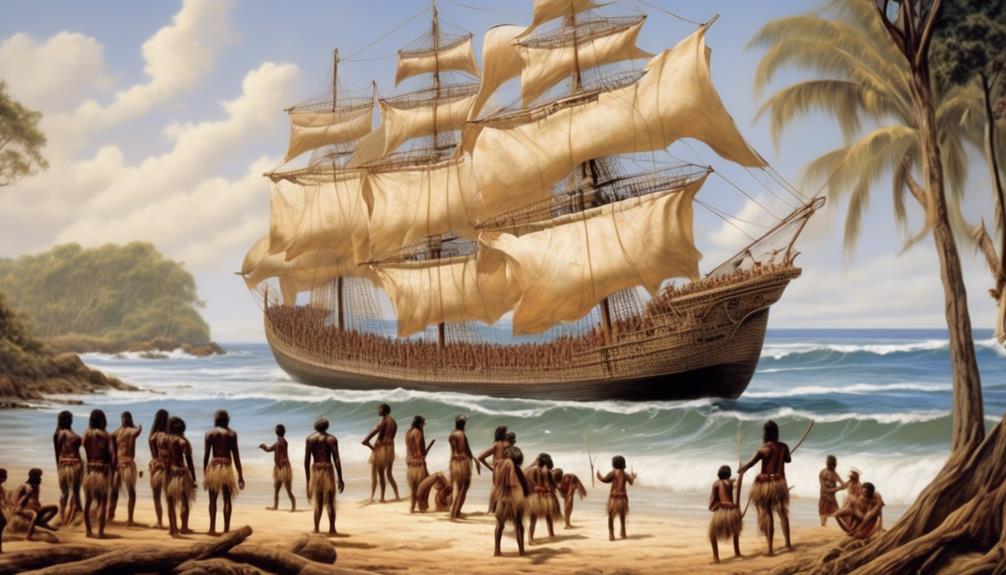
Engaging with the challenges of adapting to diverse environments, our communities have demonstrated resilience through innovative strategies and resourceful practices. When examining aboriginal resistance and European adaptation, it's evident that both groups utilized different approaches in response to the arrival of Europeans.
- Aboriginal Resistance: Aboriginal communities displayed remarkable resistance through their deep understanding of the land, effective guerrilla warfare tactics, and preservation of cultural knowledge, enabling them to withstand European encroachment.
- European Adaptation: In contrast, Europeans adapted by leveraging advanced technology, exploiting natural resources, and implementing systematic colonization strategies, which allowed them to establish dominance over the land and its indigenous inhabitants.
The comparison between aboriginal resistance and European adaptation highlights the complex dynamics at play during the interactions between these groups. While aboriginal communities fiercely defended their way of life, European settlers employed transformative methods to assert their dominance.
Understanding these dynamics is crucial in comprehending the historical processes that shaped the outcomes for both groups and the lasting impact on their respective societies.
Impact of Colonization
How did the colonization impact the social and cultural fabric of both the Aboriginal Australians and the Natives of New Guinea?
The impact of colonization on the social and cultural structures of the Aboriginal Australians and the Natives of New Guinea was profound and multifaceted. Cultural assimilation was a common outcome for both groups, albeit to varying degrees. The imposition of European cultural norms and values led to the erosion of traditional practices and belief systems, resulting in a loss of cultural identity for many individuals within these communities. This process of cultural assimilation was more pronounced in the case of the Aboriginal Australians due to the more direct and prolonged contact with European settlers.
Societal displacement was another significant consequence of colonization for both groups. The arrival of European colonizers disrupted existing social structures and hierarchies, leading to widespread dislocation and upheaval within the Aboriginal Australian and New Guinean societies. This displacement resulted in significant challenges in preserving traditional social systems and community cohesion, as well as in adapting to the new social order imposed by the colonizers.
The impact of colonization on the social and cultural fabric of these indigenous communities continues to reverberate through their societies today, shaping their ongoing struggles for cultural preservation and self-determination.
Frequently Asked Questions
What Role Did Religious and Cultural Beliefs Play in the Europeans' Ability to Replace the Aboriginal Australians?
The role of spirituality and cultural beliefs was significant in the Europeans' ability to replace the Aboriginal Australians. Religious influence and cultural assimilation played a key role in colonization, impacting the displacement of indigenous belief systems.
The Europeans' approach to cultural integration and the impact of their beliefs on colonization were pivotal in this context. These factors contributed to their ability to replace the Aboriginal Australians but not the natives of New Guinea.
Were There Any Significant Differences in the Europeans' Approach to Colonization in Australia Compared to New Guinea?
In comparing the Europeans' strategies in colonizing Australia and New Guinea, we find significant differences in their approach.
Cultural differences, colonization tactics, social dynamics, disease impact, and resource exploitation all played a role.
The Europeans encountered more resistance in New Guinea due to the rugged terrain and the fierce independence of the local tribes.
In Australia, they were able to exploit the land more effectively and encountered less resistance from the indigenous population.
How Did the Introduction of New Diseases Impact the Ability of Europeans to Replace the Aboriginal Australians and the Natives of New Guinea?
The introduction of new diseases had a significant impact on the ability of Europeans to replace the Aboriginal Australians and the natives of New Guinea.
The epidemic consequences of diseases like smallpox drastically reduced the indigenous populations, affecting their ability to resist colonization.
This, coupled with differences in cultural beliefs and colonization dynamics, resulted in varying outcomes for the two groups.
It's a stark reminder of the devastating impact of disease on vulnerable populations during historical periods of contact.
What Impact Did the Presence of Valuable Resources Have on the Colonization of Australia and New Guinea?
The impact of resources on colonization dynamics was significant.
The availability of valuable resources in Australia attracted European settlers, leading to their ability to replace the Aboriginal Australians.
In contrast, the limited presence of valuable resources in New Guinea may have deterred European colonization, allowing the natives to maintain their autonomy.
This disparity in resource availability influenced the dynamics of colonization in these regions, shaping the outcomes for the indigenous populations.
How Did the Europeans' Interactions With Other Indigenous Groups in the Region Affect Their Ability to Replace the Aboriginal Australians and the Natives of New Guinea?
As we explore the impact of trade and cultural assimilation on the Europeans' interactions with indigenous groups, we find that these dynamics influenced their ability to replace the Aboriginal Australians and the natives of New Guinea.
The exchange of resources and the assimilation of cultural practices affected the power dynamics and relationships, contributing to the differing outcomes in these regions.
Such interactions were pivotal in shaping the historical outcomes for these groups.
Conclusion
In conclusion, Europeans were able to replace the aboriginal Australians but not the natives of New Guinea due to their advanced agricultural practices, environmental factors, and the impact of colonization.
The Europeans' expansion was facilitated by their ability to adapt and resist, while the New Guineans' resistance and adaptation, along with their environmental factors, posed significant challenges.
Ultimately, it was a combination of factors that determined the outcome of European colonization in these regions.
Mary is a passionate writer who brings creativity and a fresh perspective to our team. Her words have the power to captivate and inspire, making her an essential contributor to our content. Mary’s commitment to storytelling and dedication to promoting Indigenous culture ensures that her work touches the hearts of our readers. We’re fortunate to have her as part of our team.
